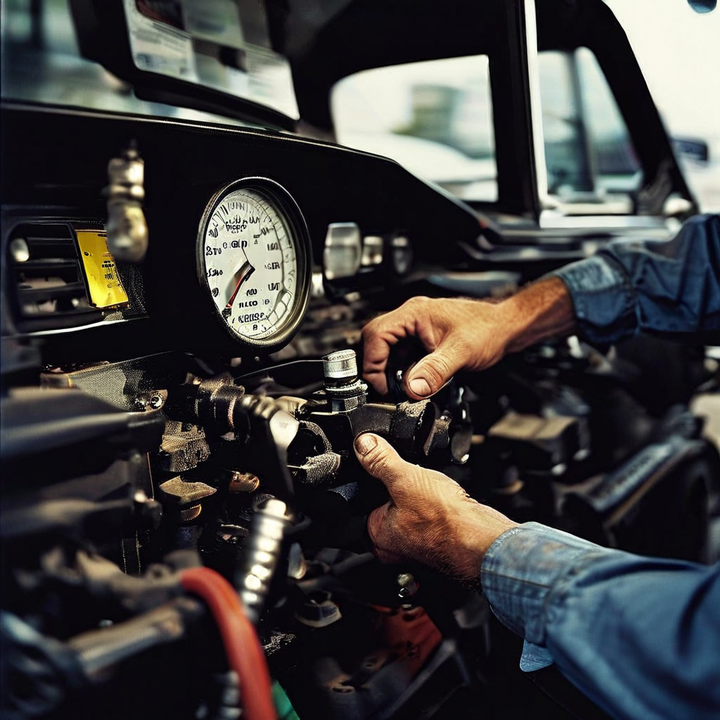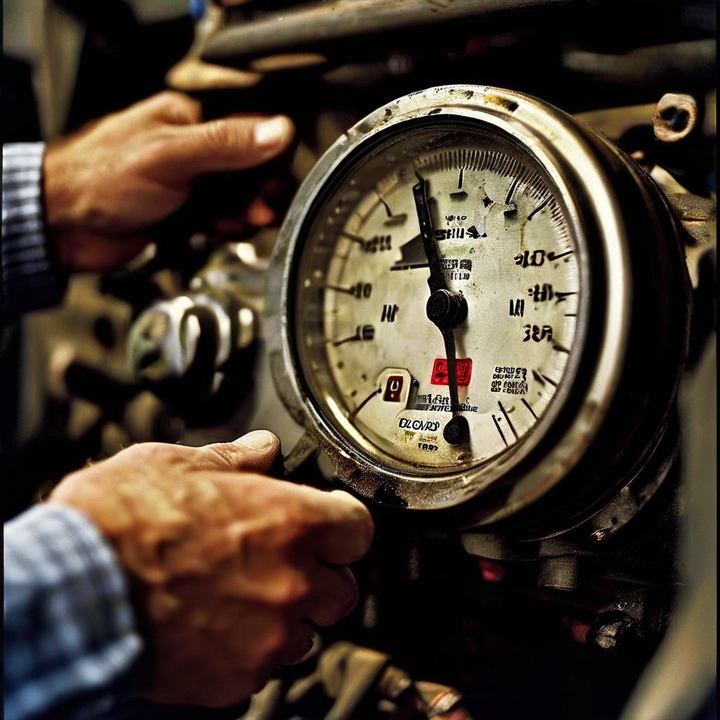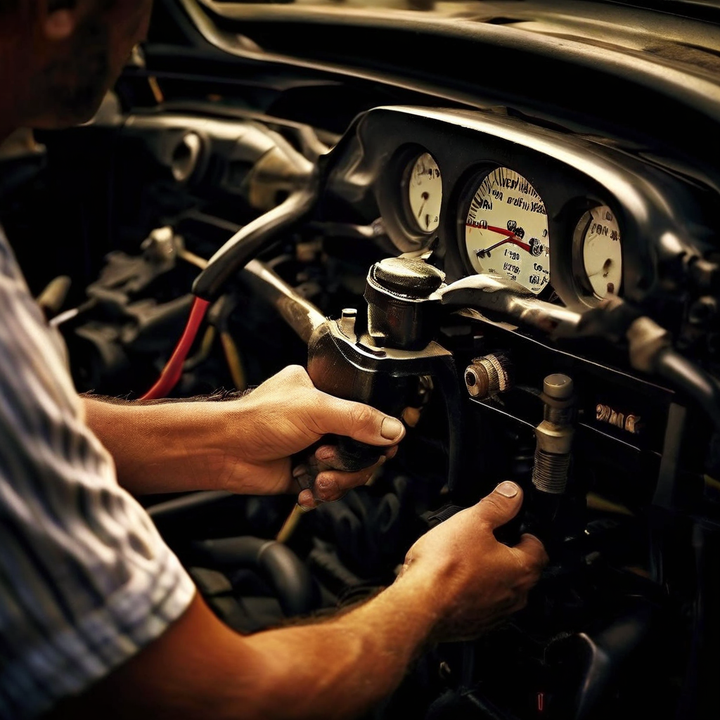


Oil pressure is a critical factor in ensuring the proper lubrication and functioning of an engine. It refers to the force that drives the engine oil through the various components, providing a thin film of lubrication between moving parts. Maintaining the correct oil pressure is essential for prolonged engine life and optimal performance.

Before we dive into the details, let's establish a solid understanding of oil pressure. Oil pressure refers to the force exerted by the engine's lubricating oil as it circulates through various components. Adequate oil pressure is essential for maintaining proper lubrication, reducing friction, and preventing premature wear and tear on critical engine parts like bearings, pistons, and cylinder walls.
Now, you might be wondering, "What constitutes a 'good' oil pressure?" The answer isn't as straightforward as you might think. Optimal oil pressure can vary depending on factors such as the engine's design, age, and operating conditions. However, here's a general guideline:
| Engine Condition | Recommended Oil Pressure Range |
|---|---|
| At normal operating temperature and idling speed | 25 to 65 PSI (pounds per square inch) |
| During acceleration or high RPMs | Higher pressures, typically up to 80 PSI |
It's important to note that these ranges are approximate and can vary based on the specific vehicle manufacturer's recommendations. Always consult your owner's manual or seek professional advice for the most accurate information.
Deviations from the recommended oil pressure range can be indicative of underlying issues that require prompt attention. Let's explore some of the common culprits behind low and high oil pressure scenarios.
Low oil level due to leaks, burning, or overdue oil changes
Incorrect oil viscosity (too thin)
Worn engine components like bearings, piston rings, and cylinder walls
Faulty or clogged oil pump
Blocked oil pickup tube or filter
Blocked oil passages or stuck relief valve
Incorrect oil viscosity (too thick)
Faulty oil pressure sensor or sending unit
Dirty or clogged oil filter
Now, let's dive deeper into each of these causes and their potential consequences.
One of the most common causes of low oil pressure is a low oil level. This can be due to various reasons:
Oil leaks: Leaks can occur in various areas, such as gaskets, seals, or even cracks in the engine block or oil pan. Even minor leaks can lead to a gradual loss of oil over time.
Burning oil: Excessive oil consumption, often caused by worn piston rings or valve guides, can result in a low oil level.
Overdue oil changes: Neglecting to change your oil at the recommended intervals can lead to oil degradation and a decrease in oil level.
When the oil level is low, the oil pump may struggle to circulate an adequate amount of oil, leading to reduced pressure and increased wear on engine components.
Using the wrong oil viscosity (thickness) can also contribute to low oil pressure. If the oil is too thin, it may not provide adequate lubrication, resulting in increased friction and wear.
Different engines require specific oil viscosities based on their design and operating conditions. Using an oil that's too thin for your engine can lead to increased clearances between moving parts, reducing the oil's ability to maintain proper pressure.
Over time, engine components like bearings, piston rings, and cylinder walls can wear down, causing increased clearances and reduced oil pressure. As these components wear, the oil has more space to flow through, resulting in lower pressure.
Worn bearings, in particular, can significantly impact oil pressure. Bearings are responsible for supporting and allowing smooth rotation of the crankshaft and other moving parts. As they wear down, the increased clearances can cause a drop in oil pressure.
The oil pump is a critical component responsible for circulating the lubricant throughout the engine. If the oil pump is faulty or clogged, it may not be able to generate sufficient pressure to properly lubricate the engine components.
A faulty oil pump can be caused by various factors, such as worn internal components, a broken drive shaft, or a clogged pickup tube. In any case, a malfunctioning oil pump can lead to inadequate oil pressure, potentially causing severe engine damage if left unaddressed.
The oil pickup tube is responsible for drawing oil from the oil pan and delivering it to the oil pump. If this tube becomes blocked or obstructed, it can restrict the flow of oil, leading to low oil pressure.
Similarly, a clogged oil filter can also contribute to low oil pressure. The oil filter is designed to remove contaminants from the oil, but if it becomes excessively clogged, it can restrict the flow of oil, reducing the pressure in the system.
While low oil pressure is more common and potentially more damaging, excessively high oil pressure can also be problematic. Here are some potential causes:
Oil passages within the engine are designed to allow the oil to circulate freely. However, if these passages become clogged or blocked, it can prevent the oil from flowing properly, resulting in increased pressure.
Similarly, the oil relief valve is a critical component that regulates oil pressure by allowing excess oil to bypass the system when the pressure becomes too high. If this valve becomes stuck or fails to open properly, it can cause a buildup of pressure within the engine.
Just as using an oil that's too thin can cause low pressure, using an oil that's too thick for your engine can also lead to high oil pressure. When the oil is too viscous (thick), it becomes more resistant to flow, causing increased pressure within the system.
It's essential to use the recommended oil viscosity for your specific engine, as specified by the manufacturer. Using an oil that's too thick can put unnecessary strain on the oil pump and other components, potentially leading to damage over time.
In some cases, the issue may not be with the oil pressure itself but rather with the sensor or sending unit responsible for reporting the readings. A faulty oil pressure sensor or sending unit can provide inaccurate readings, indicating high oil pressure when the actual pressure is within the normal range.
While this issue may not directly impact the engine's performance, it can lead to unnecessary concern and potentially mask other underlying problems.
A dirty or clogged oil filter can restrict the flow of oil, causing an increase in pressure within the system. As the filter becomes increasingly clogged, it creates resistance to the oil flow, forcing the oil pump to work harder and generate higher pressures.
Regular oil filter changes are essential to prevent this issue and ensure proper oil circulation and pressure regulation.
Now that we've covered the potential causes, let's discuss how to diagnose and address oil pressure issues effectively.
Check Oil Level and Condition: The first step is to check your oil level using the dipstick. While you're at it, inspect the oil's condition – if it appears dirty or contaminated, it may be time for a change.
Inspect for Leaks: Look for any signs of oil leaks, as these can contribute to low oil levels and pressure. Common areas to check include gaskets, seals, and the oil pan.
Listen for Abnormal Noises: If you hear unusual knocking, tapping, or grinding noises coming from your engine, it could be an indication of worn components or insufficient lubrication.
Check Warning Lights: Keep an eye on your oil pressure warning light. If it's illuminated, it's a clear sign that your oil pressure is outside the recommended range.
Once you've identified the root cause of the abnormal oil pressure, it's time to take corrective action. Here are some common repair instructions:
Low Oil Level: If the issue is simply a low oil level, top it up with the recommended oil and address any leaks.
Incorrect Viscosity: Switch to the manufacturer-specified oil viscosity for your engine.
Worn Components: In cases of severe wear, an engine overhaul or rebuild may be necessary to replace the damaged components.
Faulty Oil Pump: If the oil pump is faulty, it will need to be replaced.
Blocked Passages or Filter: Clean or replace any blocked oil passages, pickup tubes, or filters.
Faulty Sensor: If the issue lies with the oil pressure sensor or sending unit, replace it with a new one.
While addressing the immediate issue is crucial, it's equally important to take preventive measures to avoid future oil pressure problems. Here are some tips:

Use Approved Oil Viscosity and Quality: Always use the recommended oil viscosity and quality for your specific engine. Consult your owner's manual or seek advice from a professional mechanic.
Inspect for Leaks: During oil changes, take the opportunity to inspect for any signs of leaks that could contribute to low oil levels and pressure.
Consider Oil Additives: In some cases, using high-quality oil additives can help reduce sludge buildup and improve overall engine lubrication.
Addressing oil pressure issues can come with varying costs, depending on the severity of the problem. Here's a general breakdown:
Oil and Filter Change: Typically ranges from $30 to $100, depending on your vehicle and the cost of labor.
Oil Pressure Sensor Replacement: Expect to pay between $25 and $200 for the part and labor.
Oil Pump Replacement: This can be a more significant expense, ranging from $300 to $1,000 or more, including parts and labor.
Major Engine Work (Overhaul or Rebuild): In cases of severe wear or damage, a complete engine overhaul or rebuild may be necessary, which can cost anywhere from $2,000 to $5,000 or more.
Remember, ignoring abnormal oil pressure can lead to catastrophic engine failure, which would be far more costly in the long run. Regular maintenance and prompt attention to any issues are crucial for preserving the health and longevity of your vehicle.
Maintaining proper oil pressure is essential for the well-being of your engine, and understanding the factors that influence it is the first step towards ensuring your vehicle's longevity. By being vigilant, addressing issues promptly, and following recommended maintenance practices, you can keep your engine running smoothly and avoid costly repairs down the line.
As a mechanic, I've witnessed firsthand the consequences of neglecting oil pressure issues, and I cannot stress enough the importance of taking proactive measures. Whether it's a simple oil change or a more complex repair, addressing oil pressure concerns should be a top priority for any responsible vehicle owner.
So, the next time you notice an abnormal oil pressure reading or warning light, don't hesitate to seek professional assistance. Your engine will thank you for the care and attention you've given it.
Happy motoring, and remember, a well-maintained vehicle is a happy vehicle!
The ideal oil pressure range for most vehicles is typically between 25 to 65 PSI at normal operating temperature and idling speed. During acceleration or high RPMs, higher pressures up to around 80 PSI are common.
Low oil level due to leaks, burning, or overdue oil changes can cause low oil pressure as the oil pump struggles to circulate an inadequate amount of oil.
Yes, using an oil viscosity that is too thin or too thick for your engine can lead to low or high oil pressure readings respectively.
Excessive engine noise, poor acceleration, and rough idling can indicate worn bearings, piston rings, or cylinder walls that are allowing oil to bypass and reducing pressure.
A faulty, worn, or clogged oil pump may not be able to generate sufficient pressure to properly lubricate the engine components, leading to low oil pressure.
Yes, if the oil pickup tube or filter becomes obstructed or clogged, it can restrict oil flow and result in low oil pressure readings.
High oil pressure can be caused by blocked oil passages, a stuck relief valve, incorrect (too thick) oil viscosity, or a faulty oil pressure sensor/sending unit.
No, it is not safe to drive with low oil pressure as it can lead to increased friction, overheating, and potential engine damage or failure if not addressed promptly.
Oil pressure should be checked regularly, especially during routine oil changes or if the oil pressure warning light illuminates on the dashboard.
Following recommended service intervals, using the correct oil viscosity, inspecting for leaks, and considering high-quality oil additives can help prevent low or high oil pressure issues.

Sarah isn't your average gearhead. With a double major in Mechanical Engineering and Automotive Technology, she dived straight into the world of car repair. After 15 years of turning wrenches at dealerships and independent shops, Sarah joined MICDOT to share her expertise and passion for making cars run like new. Her in-depth knowledge and knack for explaining complex issues in simple terms make her a valuable asset to our team.








